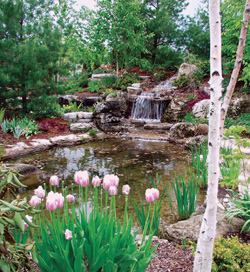In nature, you will find relatively flat stones, but they’re not honed or polished. And the water will fall in rougher curtains, not uniform ¼-inch- to ½-inch-thick sheets.
Try to avoid the shelf effect. If you want to work with a flatter stone, look for something that isn’t too uniformly flat. Use something at least a few inches thick, so it doesn’t act as a knife edge, then consider softening it with smaller stones on top.
Rounder stones also make nice falls. It’s true, they won’t give you that Niagara Falls effect, but they can create more original flow patterns. A single large, round rock can emit a gentle trickle that’s very soothing. Or sculpt the flow to move between stones.
Partially bury marginal rocks. Boulders should not sit on the edge of the pool like a coping stone or, worse, on top of a coping stone. Build them into the pool shell and deck so that they look buried on land and submerged in water. Some contractors bury their larger pieces by more than half.
Build shelves around the pool to hold the rock. Make them large enough to hold sizeable boulders. Otherwise, you’ll be stuck trying to cram smaller pieces onto the shelf, which doesn’t look authentic.
Conceal manmade components. Hide all signs of construction. Cement the stones together with darker-colored mortars and grouts, say gray or black. Place the material toward the back of the joints so you don’t see it.
Also, hide the feed lines for waterfalls. Fittings should not stick out of the stone. Try building a sizeable source pool on top and place the fittings for the feed line toward the bottom. This way, the plumbing is well submerged, and any water agitation will stay below the surface. The pool can well up and over-flow, causing a subtle spilling effect.

